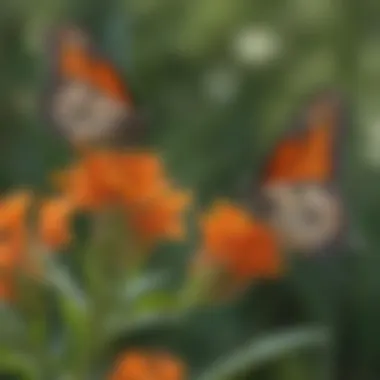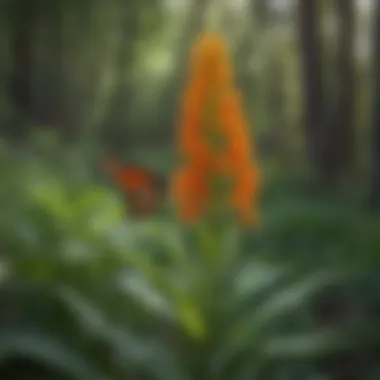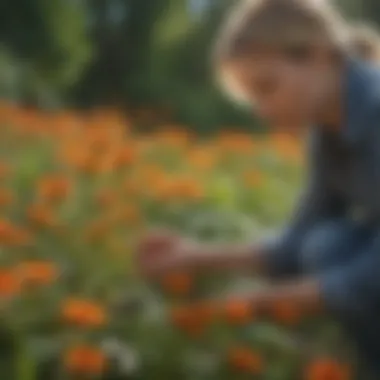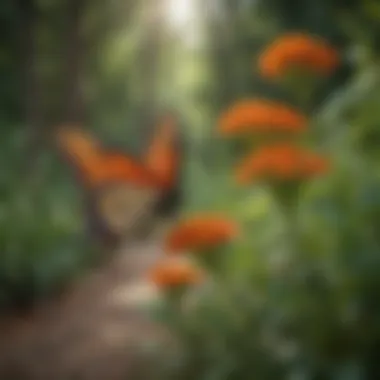Explore the Ecological Importance of Native Butterfly Weed


Intro
Native butterfly weed, scientifically known as Asclepias tuberosa, is a perennial plant that holds high ecological significance. This species, characterized by its vibrant orange flowers and resilience in various habitats, plays a vital role in supporting local ecosystems. Its relationship with pollinators, especially butterflies, encourages biodiversity and enhances the health of natural communities.
Understanding the nuances of butterfly weed requires a broader scope of inquiry. It is important to understand how forestry practices, conservation techniques, and sustainable management strategies intersect with the livelihood of this crucial plant. The knowledge acquired through studying butterfly weed ultimately contributes to efforts aimed at preserving this essential species.
This article will explore several avenues related to butterfly weed. First, it will detail its ecological significance, including its interactions with pollinators. Next, it will delve into cultivation methods and best practices for propagation. Finally, it highlights conservation considerations necessary for ensuring the longevity of native butterfly weed, providing a comprehensive look at how individuals can be part of this vital effort.
Understanding Forestry Practices
Forestry practices have significant implications for the survival and promotion of native butterfly weed.
Types of Forestry Practices
There are several key forestry practices that relate to butterfly weed cultivation and conservation:
- Sustainable Logging: Techniques that minimize environmental impact can help maintain the habitat needed for butterfly weed.
- Reforestation: Planting native species in deforested areas can provide new habitats and promote the growth of butterfly weed.
- Controlled Burning: This method can manage plant communities and help maintain open spaces where butterfly weed thrives.
Historical Context
Historically, land management strategies have evolved. Early practices often disregarded the impact on native flora, including butterfly weed. Awareness of ecological relationships has grown, emphasizing responsible forestry methods to benefit plant species. By learning from past practices, forestry professionals can implement effective approaches which promote the health of ecosystems.
Principles of Woodland Stewardship
Woodland stewardship involves responsible management of forest resources while conserving biodiversity, including butterfly weed.
Conservation Techniques
Using successful conservation methods ensures the well-being of butterfly weed populations. These techniques include:
- Protecting existing habitats from invasive species.
- Educating local communities about the ecological importance of butterfly weed and its role in supporting pollinators.
- Implementing habitat restoration projects to revive degraded areas.
Managing Forest Resources
Effective management practices are vital. By balancing resource access while preserving native flora, forestry professionals can foster environments that support butterfly weed growth. This includes maintaining soil health and ensuring adequate water supply.
Sustainable Forest Management
Sustainable forest management is critical for the persistence of butterfly weed.
Certification Standards
Various certification programs ensure that forestry practices align with sustainable principles. Programs like the Forest Stewardship Council (FSC) advocate for responsible forestry, directly contributing to the preservation of vital native species.
Economic Benefits of Sustainability
Investing in sustainable practices creates long-term economic benefits. Healthy ecosystems yield timber, recreational opportunities, and tourism while sustaining species such as butterfly weed. Understanding the economic imperative can encourage adoption of better practices across the forestry sector.
"The relationship between forests and native flora, such as butterfly weed, is a cornerstone of ecosystem stability and resilience."
In summary, the comprehensive study of native butterfly weed is intricately tied to the practices within woodland stewardship, sustainable management, and woodland conservation initiatives. By recognizing the vital link between these areas, stakeholders can better understand how to support and advance this essential species for future generations.
Prelims to Native Butterfly Weed


Native butterfly weed, scientifically known as Asclepias tuberosa, plays a crucial role in both ecological systems and human experiences. Its vibrant orange and yellow flowers not only bring beauty to gardens but also serve essential functions in the environment. By examining its significance, we gain insights into its ecological relationships and benefits in biodiversity.
Definition and Taxonomy
Native butterfly weed belongs to the Apocynaceae family. This family includes plants such as milkweed and dogbane. The taxonomic classification of butterfly weed includes the following:
- Kingdom: Plantae
- Phylum: Angiosperms
- Class: Eudicots
- Order: Gentianales
- Family: Apocynaceae
- Genus: Asclepias
- Species: A. tuberosa
Butterfly weed’s characteristics set it apart from other species in the Asclepias genus. It has a unique morphology. The plant often grows between one and three feet tall, with dense clusters of bright flowers that bloom in summer. Its thick, greyish-green leaves are distinct and add to its overall resilience. This resilience allows it to thrive in various habitats.
History and Cultural Significance
Historically, Asclepias tuberosa has been valued by various cultures. Indigenous peoples utilized the plant for its medicinal properties. They recognized its potential in treating ailments such as respiratory issues and fever. The plant’s fibrous roots were also used in textile production.
In contemporary culture, butterfly weed has gained significant recognition among gardeners and environmentalists. Its role in supporting monarch butterfly populations has become a focal point. As urban areas expand, the need for plants that attract pollinators has increased. This has led to a resurgence of interest in native plant gardens that include butterfly weed.
"Native butterfly weed is not merely a plant; it is a keystone species that supports various other forms of life within its ecosystem."
In summary, understanding native butterfly weed extends beyond mere classification or aesthetic appeal. It embodies a blend of ecological importance and cultural heritage, making it a vital subject of study for conservationists and those passionate about environmental sustainability.
Ecological Role of Native Butterfly Weed
Native butterfly weed has an essential ecological role in various ecosystems. It offers critical benefits that enhance the habitats in which it is found. This section will delve into the habitat preferences of butterfly weed, its interactions with pollinators, and its contributions to overall biodiversity.
Habitat Preferences
Native butterfly weed, also known as Asclepias tuberosa, thrives in well-drained soils. It prefers sunny locations that receive ample sunlight throughout the day. This plant is commonly found in open fields, meadows, and roadside areas. It can adapt to different soil types, but sandy and loamy soils are particularly favorable.
Some key habitat characteristics include:
- Moisture: Butterfly weed does not tolerate excessive moisture. Ideal conditions involve average water levels that do not lead to waterlogged soils.
- pH Levels: Neutral to slightly alkaline soil pH is optimal. Adjusting the soil pH can promote better growth and flowering.
- Competition: This plant can struggle against aggressive weeds. Thus, a habitat with low competition from other plant species can enhance its growth.
By understanding these preferences, conservationists can create environments conducive to butterfly weed, thereby supporting its presence in native ecosystems.
Interactions with Pollinators
Pollinators play a fundamental role in the life cycle of native butterfly weed. The flowers of Asclepias tuberosa are particularly attractive to various species of butterflies, bees, and other pollinating insects. Pollination is vital for producing seeds and maintaining the species population.
Some noteworthy points include:
- Nectar Production: Butterfly weed produces abundant nectar, which is highly attractive to pollinators. This characteristic increases its role in sustaining local pollinator populations.
- Specialized Relationships: Certain species, like the monarch butterfly, have evolved specific relationships with butterfly weed. This unique connection highlights the species' role in supporting not just biodiversity but also the life cycles of specific pollinators.
- Ecosystem Interdependency: The interactions between butterfly weed and pollinators demonstrate a broader ecological web. The health of the butterfly population indicates the overall health of the ecosystem.
The presence of native butterfly weed enhances pollinator activity, ultimately contributing to the sustainability of local ecosystems.
Contribution to Biodiversity
Certainly, butterfly weed plays a significant part in supporting biodiversity. By fulfilling its role as a native plant species, it helps to maintain the balance within various ecosystems.
Key contributions of butterfly weed include:
- Habitat Structure: As a perennial plant, it adds vertical diversity to habitats, providing shelter and food sources for various wildlife.
- Nutrient Cycling: The decomposition of butterfly weed contributes to soil health by returning nutrients to the soil, benefiting surrounding plants.
- Supporting other Species: Butterfly weed not only attracts pollinators but also supports herbivores, which rely on it for food. This creates multiple layers of interaction within the ecosystem.
In summary, the ecological role of native butterfly weed extends far beyond its striking appearance. It is an integral part of its habitat, offering numerous benefits to pollinators, supporting biodiversity, and highlighting the importance of conservation efforts in safeguarding its future.
Cultivation Techniques


Cultivation techniques are crucial for the successful growth and sustainability of native butterfly weed. Understanding these methods not only aids in fostering healthy plants but also benefits the local ecosystem where these plants thrive. As butterfly weed is known for its resilience and natural beauty, cultivating it can enhance biodiversity in gardens and natural settings. Key considerations include proper seed collection, adequate soil requirements, and effective pest management practices.
Seed Collection and Propagation
Seed collection is an essential first step when cultivating native butterfly weed. Timing is crucial; seeds should be harvested in the late summer or early fall when they are fully mature. It is essential to collect seeds from healthy plants. Gather dried seed pods before they burst, as this prevents loss of seeds. Store the seeds in a cool, dry place until planting.
Once seeds are prepared, propagation can be executed either through direct sowing or using seed trays. Direct sowing should occur in the spring after the last frost. Alternatively, seed trays can be used indoors. Transplant seedlings outdoors once they are strong enough, usually after about 6-8 weeks.
"Successful propagation of native butterfly weed helps maintain its populations and supports local biodiversity."
Soil and Environmental Requirements
Butterfly weed thrives in well-draining soil that is moderately fertile. The plant prefers sandy or loamy soils with a pH ranging from 6.0 to 7.0. Avoid overly rich soils, as these can promote excessive leaf growth at the expense of flowers. To achieve optimal growth, it is important to ensure that the site receives full sun, as butterfly weed requires at least six hours of sunlight daily.
Other environmental factors to consider include drainage and moisture levels. Although butterfly weed is drought-tolerant once established, it requires regular watering in the initial stages of growth. Monitoring these conditions helps facilitate healthy development and vibrant flowering.
Pest and Disease Management
Pest and disease management is vital in maintaining the health of native butterfly weed. Common pests include aphids and spider mites, which can cause substantial harm to young plants. Regular inspection of foliage for signs of infestation is important. If pests are detected, they can often be removed by washing them off with water or applying insecticidal soap as a treatment option.
Regarding diseases, maintenance of proper spacing between plants allows for adequate airflow, reducing the risk of fungal infections. In addition, practicing crop rotation can prevent soil-borne diseases. Keeping the garden clean by removing debris also mitigates potential disease threats.
Incorporating these cultivation techniques enhances the growth and resilience of native butterfly weed. This effort is significant in supporting the overall health of ecosystems while promoting the beauty of natural landscapes.
The Importance of Native Butterfly Weed in Gardening
Native butterfly weed holds significant value in gardening beyond its vibrant appearance. This plant serves multiple purposes that benefit not just the garden itself but also the ecological system within which it resides. Understanding these aspects can help gardeners make informed choices that align with their aesthetic and environmental goals.
Attracting Pollinators
One of the fundamental reasons to include native butterfly weed in a garden is its ability to attract pollinators. Yhere are several species of butterflies that specifically rely on this plant for nectar. Monarch butterflies are perhaps the most well-known example, showcasing a remarkable dependency on it for their lifecycle. The bright orange flowers of butterfly weed are particularly appealing to these pollinators.
Moreover, not just butterflies benefit. Native bees and other insects also find nourishment in this plant. As a nectar source, butterfly weed can increase pollinator activity in your garden, bolstering the pollination of other plants. This is particularly crucial for those planning to grow fruits or vegetables, as increased pollination directly correlates to higher yields. The presence of such diverse pollinator populations can enhance the overall health of the ecosystem.
Aesthetic Value in Landscapes
Aesthetically, native butterfly weed adds a striking visual component to gardens. Its bright orange and yellow flowers can contrast beautifully with a variety of other plants. Using native plants like butterfly weed can create a sense of place in a garden, showcasing the regional flora. This connection to local ecology can evoke a sense of pride and responsibility towards preserving native species.
Additionally, incorporating native butterfly weed into landscape design can lead to lower maintenance gardens. Adapted to local soil and climate conditions, this plant typically requires less water and fewer fertilizers than non-native species. A sustainable garden that is both beautiful and functional is attainable through the inclusion of native plants.
Supporting Ecological Balance
Integrating native butterfly weed into gardens contributes to ecological balance. Native plants often have established relationships with local wildlife. By planting butterfly weed, gardeners support the local ecosystem and promote biodiversity. This is especially important in areas where natural habitats have been diminished.
"Native plant gardens can serve as critical habitats for wildlife, especially in urban settings where natural spaces are dwindling."
Depending on the local environment, butterfly weed can provide shelter for various organisms, including caterpillars. Enhancing habitat for these creatures fosters ecological interactions that sustain a healthy ecosystem. Furthermore, by encouraging native plant growth, gardeners can aid in controlling invasive plant species, thereby preserving ecological integrity.
Conservation Challenges
The conservation challenges faced by native butterfly weed stem from multiple factors that threaten its existence in various habitats. Addressing these challenges is crucial to ensuring the survival of this important species. Through understanding the specific threats, the impact of urbanization, and the effects of climate change, conservationists can develop effective strategies to protect and restore butterfly weed populations. The need for sustained efforts in conservation reflects the species’ importance in local ecosystems and in supporting biodiversity.
Threats to Native Populations
Native butterfly weed faces several threats that jeopardize its populations. Habitat loss is one of the most significant. This often results from agricultural expansion, land development, and resource extraction. When land is converted for these purposes, native plants like butterfly weed are often eliminated or fragmented.
Invasive species also pose a serious risk. They compete for resources such as light, water, and nutrients, often overpowering native flora. Recognizing the role of these invaders is critical. For successful conservation efforts, invasive species must be managed effectively. Additionally, overharvesting can lead to reduced genetic diversity, further weakening the population resilience.


Impact of Urbanization and Development
Urbanization and development greatly affect the habitats of native butterfly weed. As cities expand, natural areas are increasingly turned into residential and commercial zones. This process alters the local environment. The remaining plots of habitat may become isolated, making it challenging for pollinators and other wildlife to access them.
Moreover, urban pollution can degrade the quality of the surrounding ecosystem, impacting soil and water conditions necessary for the growth of butterfly weed. Strategies for better urban planning are essential. Integrating green spaces and native plant gardens into urban areas can help mitigate these effects and promote biodiversity.
Climate Change Effects
Climate change poses a looming challenge to native butterfly weed. As temperatures rise and weather patterns shift, the environments suitable for this species are also changing. Altered rainfall patterns can lead to droughts or flood conditions that can be detrimental to its growth.
Furthermore, the changing climate may shift the distribution of butterfly weed and its pollinators. If these shifts occur too rapidly, plant populations may not adapt quickly enough. Conservation strategies must therefore consider these dynamics. Emphasizing adaptive management practices will be vital in responding to the unpredictable nature of climatic effects on butterfly weed.
"Conservation of native plant species is not merely about the plants themselves. It involves a broader context of biodiversity that supports entire ecosystems."
Future Directions in Butterfly Weed Conservation
The future of butterfly weed conservation is a critical topic that warrants thorough examination. As ecosystems face pressures from climate change, urbanization, and habitat loss, it is imperative to explore viable strategies that can ensure the survival and growth of native butterfly weed populations. By focusing on restoration projects, community engagement, and innovative research collaborations, stakeholders can play a pivotal role in enhancing the resilience of this species.
Restoration Projects
Restoration projects are fundamental for reviving native butterfly weed populations. These projects focus on reestablishing butterfly weed in regions where its numbers have declined due to human intervention or ecological shifts.
To effectively implement these initiatives, it is essential to select suitable sites for planting, ensuring that the environmental conditions reflect the plant's natural habitat. Native seed mixes can be used to create a diverse plant community. Furthermore, ongoing monitoring is crucial to assess the health of the planted areas. When planning restoration, engaging landowners and local authorities can facilitate smoother execution and support.
Key aspects of successful restoration projects include:
- Site Selection: Identify locations that mirror historic habitats.
- Seed Sourcing: Utilize locally sourced seeds to maintain genetic diversity.
- Monitoring: Regular assessments to track growth and pollinator activity.
Community Involvement in Conservation
Community engagement is vital for the conservation of butterfly weed. When local communities become informed and involved, they can significantly contribute to conservation efforts. Active participation in planting events or educational workshops fosters a shared sense of responsibility.
Creating awareness about the ecological role of butterfly weed can stimulate greater public interest. Schools and organizations can develop educational programs focusing on its role in supporting pollinators and promoting biodiversity. Moreover, social media platforms, such as Facebook and Reddit, can be effective in spreading awareness and mobilizing grassroots efforts.
Benefits of community involvement include:
- Educational Outreach: Programs in schools to engage youth.
- Events: Organizing community planting days.
- Volunteering: Opportunities for people to directly contribute.
Research Frontiers and Collaboration
Research plays a crucial role in understanding the factors that influence butterfly weed populations. Scientific studies can produce insights on the ecological needs of the plant, its responses to climate shifts, and effective practices for conservation. Additionally, collaboration between universities, research institutions, and environmental organizations can drive innovation.
Establishing partnerships for research can enhance data collection and provide a diverse range of perspectives. Collaborative efforts can include:
- Field Studies: Collect data on butterfly weed growth in various conditions.
- Seed Banks: Development of facilities for preserving genetic diversity.
- Shared Resources: Pooling funds and expertise for larger projects.
By prioritizing restoration, community engagement, and research, stakeholders can significantly influence the landscape for butterfly weed conservation.
Ending
In exploring the various dimensions of native butterfly weed, one must underscore the significance of effective conservation practices. This article has presented a thorough examination of the ecological roles native butterfly weed plays, its cultivation strategies, and the pressing challenges it faces. A cohesive understanding of these aspects is vital for stakeholders in conservation and horticulture.
Summary of Findings
The investigation into native butterfly weed reveals several key insights. Firstly, this species serves as a fundamental component of local ecosystems, providing essential resources for numerous pollinators, including various species of butterflies. Its adaptability to diverse habitats is noteworthy, as this enables it to flourish in various ecological settings across North America.
Cultivation techniques outlined in the article are pivotal for promoting healthy growth and propagation of native butterfly weed. By understanding its soil and environmental requirements, conservationists can enhance its survival rates in gardens and natural spaces. Additionally, effective pest and disease management practices are crucial for maintaining the plant's health and longevity.
The threats outlined, such as urbanization and climate change, highlight the urgency for proactive conservation strategies. Restorative efforts not only bolster native populations but also enrich biodiversity. To summarize, these findings illustrate that native butterfly weed is much more than just an ornamental plant; it is a vital contributor to ecological health.
Final Thoughts on Conservation Efforts
Looking forward, the commitment to nurturing and conserving native butterfly weed is essential. Conservation efforts must integrate community involvement and educational outreach to maximize impact. Collaborating with local gardeners, restoration groups, and educational institutions can foster a deeper appreciation for this species.
Without dedicated efforts, the consequences could be severe. The loss of native butterfly weed could disrupt local ecosystems, leading to a cascading effect on associated species. Thus, continuous education on the ecological importance of native weeds should be a priority.







